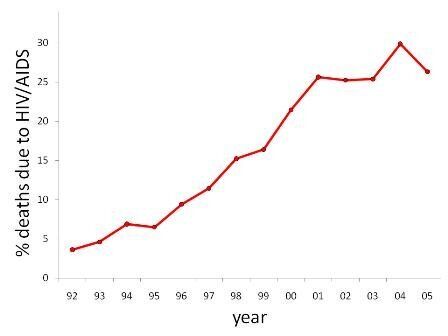We have all become used to seeing sad headlines about the numbers of people dying from HIV/AIDS. Current global estimates are well over one million per year. But have you ever asked yourself the question "Who's counting?". The truth is... at the individual level, nobody.
When scientists talk about "estimates", we generally mean using all the available evidence in a scientifically rigorous way to arrive at a figure which is as accurate as possible - but not necessarily by counting each item. For population-based data on a particular issue, ideally everybody would be accounted for individually, like in a census. But, apart from the hugely expensive and infrequent national censuses that are sometimes done, this usually doesn't happen. Consequently alternative approaches have to be taken.
If you had the job of counting HIV/AIDS deaths around the world, what would you need to know? For a start, all deaths would need to be registered - and at present this happens for less than half of the world's population. Then there is the trickier question of deciding which deaths are actually connected with HIV/AIDS. If a person living with HIV dies, does that mean that death should automatically be put down to AIDS? What if that person died in a road accident? Or had a heart attack? And what if an HIV-positive person has never been tested and nobody knew their HIV status before they died? These may be simple questions, but they are very hard to answer systematically for a national population.
Not surprisingly, in more logistically-challenged environments such as Africa the process of counting deaths systematically is much harder - and since Africa is also where most of the world's HIV/AIDS deaths occur, that makes precise global estimates quite difficult. And if reliable figures are not available, how are Ministries of Health supposed to plan and provide good services, and to know how successful their programmes are?
A new study from our team, together with colleagues at the University of the Witwatersrand in Johannesburg, describes over 6,000 deaths in a local South African population from 1992 to 2005, a period when the HIV/AIDS epidemic there was increasing rapidly. You can download the full details from the open-access journal Population Health Metrics. We used two different methods to decide on an individual basis which deaths were likely to be related to HIV/AIDS (even though most people who died hadn't been tested). Following detailed interviews with each bereaved family, local doctors were asked to assess the data and assign cause of death. In parallel, the same interview material was processed by our state-of-the-art computer model (called InterVA), which also assigned cause of death. Both sets of results were very similar - and the computer was much quicker and cheaper than the doctors.
But the sad human reality behind the results was that HIV/AIDS in this population rose from causing very few deaths in 1992 to being responsible for 1 death in every 4 across the whole population by 2005, as you can see in the graph.

For once, these are results from a setting where everyone in the community was counted, not just estimates. We need more good quality data like these from all around the world, plus good methods for interpreting them, to really understand people's health and have accurate figures on issues like the number of deaths related to HIV and AIDS. Although counting dead people might seem a little pointless, compared with saving lives, in reality mortality data are vitally important for planning and prioritising health services effectively.